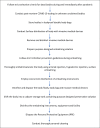The Cadaver Conundrum: Sourcing and Anatomical Embalming of Human Dead Bodies by Medical Schools during and after COVID-19 Pandemic: Review and Recommendations
- PMID: 33681708
- PMCID: PMC7917023
- DOI: 10.1007/s42399-021-00778-7
The Cadaver Conundrum: Sourcing and Anatomical Embalming of Human Dead Bodies by Medical Schools during and after COVID-19 Pandemic: Review and Recommendations
Abstract
COVID-19 pandemic has posed a new challenge for medical schools across the world regarding the acceptance of donated and unclaimed dead bodies for academic purpose. Uncertainty of the COVID-19 status among the donated bodies poses a health risk for embalming personnel and medical students who handle the embalmed cadavers. There is a paucity of literature delineating the criteria for accepting or rejecting the bodies during COVID-19 pandemic. Similarly, there is no recommended standard operating procedure for anatomical embalming during COVID-19. We propose certain criteria for accepting and rejecting the human dead bodies for anatomical embalming. And we propose some technical modifications to the conventional procedure of formalin-based anatomical embalming. A guarded approach and diligent screening of donated bodies is the way forward during the COVID-19 pandemic.
Keywords: Body donation program; COVID-19 pandemic; Cadaver; Embalming; Medical education.
© The Author(s), under exclusive licence to Springer Nature Switzerland AG part of Springer Nature 2021.
Conflict of interest statement
Conflicts of Interest/Competing InterestsOn behalf of all authors, the corresponding author states that there is no conflict of interest.
Figures
References
-
- Finegan O, Fonseca S, Guyomarc'h P, Morcillo Mendez MD, Rodriguez Gonzalez J, Tidball-Binz M, et al. ICRC advisory group on the management of COVID-19 related fatalities (2020). International Committee of the red Cross (ICRC): general guidance for the management of the dead related to COVID-19. Forensic Sci Int Synergy. 2020;31(2):129–137. doi: 10.1016/j.fsisyn.2020.03.007. - DOI - PMC - PubMed
-
- World Health Organisation. Infection Prevention and Control for the safe management of a dead body in the context of COVID-19 Interim guidance. 2020. Available at: https://apps.who.int/iris/bitstream/handle/10665/331538/WHO-COVID-19-lPC... (Accessed: 20 August 2020).
-
- World Health Organisation. Water, sanitation, hygiene, and waste management for the COVID-19 virus. Interim guidance. 2020. Available at:https://apps.who.int/iris/rest/bitstreams/1272446/retrieve (Accessed: 20 August 2020).
-
- Government of United Kingdom. Guidance for care of the deceased with suspected or confirmed coronavirus (COVID-19) 2020. Available at: https://www.gov.uk/government/publications/covid-19-guidance-for-care-of... (Accessed 20 August 2020).
-
- Government of Canada. COVID-19: Death care services and handling of dead bodies during the pandemic: Interim guidance.2020. Available at: https://www.canada.ca/en/public-health/services/diseases/2019-novel-co... (Accessed 20 August 2020).
Publication types
LinkOut - more resources
Full Text Sources
Other Literature Sources

